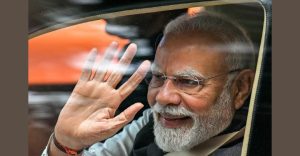
Film Ratings : ⭐⭐⭐⭐ (4/5 Stars)
War 2 unfolds as a dazzling chapter in the YRF Spy Universe, a full-scale adrenaline-rush of cinematic bravado that doesn’t just tell a story—it orchestrates an immersive sensory ride, drawing the viewer into a kaleidoscope of pulsating action, simmering tension, and surprisingly heartfelt character arcs.
Right from the first frame, the film announces its ambition: an introduction sequence bathed in sleek visuals, choreographed with almost balletic precision, and underscored by a score that throbs like a heartbeat before a chase.
When the interval strikes, the tonal shift is electric—gone is the measured build-up, replaced with a relentless surge of stunts, strategic mind games, and emotional payoffs. Hrithik Roshan once again proves why he’s one of Indian cinema’s most bankable and magnetic stars; his portrayal is a perfect cocktail of suave confidence, lived-in vulnerability, and effortless screen command, with every slow-motion glance or bone-crunching blow executed like a master craftsman.
Jr NTR, making his Bollywood debut, is nothing short of a revelation—his raw power, lightning-fast reflexes, and combustible charisma radiate through fight sequences that could rival anything in global action cinema, while his dance face-offs carry the kind of swagger that can make a theater collectively whistle. Anil Kapoor, stepping into a role that demands both gravitas and moral ambiguity, delivers a multi-layered performance—he’s the kind of screen presence that doesn’t need to shout to dominate; a subtle glance or a pause in dialogue is enough to draw the eye & a high-stakes negotiation or stepping into the fray.
The action choreography is where War 2 truly flexes its muscles—carefully constructed set pieces that balance spectacle with clarity, ensuring the audience never loses track of who’s doing what and why. The much-discussed AI-assisted combat sequences are a visual treat, blending cutting-edge technology with grounded stunt work, while the slow-motion beats—used sparingly and strategically—land like punctuation marks on an already thrilling sentence. These aren’t just action scenes; they’re mini-narratives in themselves, each advancing the plot, deepening relationships, or revealing character truths.
What’s refreshing is the restraint shown in the violence—intense without tipping into gratuitousness, always mindful of the fine line between shock and spectacle. The cinematography is a character in itself, painting each location—whether a neon-drenched metropolis, a sun-baked desert expanse, or a rain-slicked rooftop—as both a visual marvel and a tactical chessboard. The background score, composed with a keen sense of rhythm and mood, knows exactly when to surge into the foreground to amplify a jaw-dropping stunt, and when to retreat, letting silence sharpen the tension. There are even cheeky musical flourishes that nod to Shaitaan, not as imitation, but as a wink to the audience—moments of tonal playfulness amidst the high-stakes drama.
The narrative spine, while traversing familiar spy-thriller territory, benefits from the performances and direction that elevate archetypes into memorable individuals; every major player has a purpose, every emotional beat is earned. The first half invests heavily in character work, ensuring that when the betrayals, alliances, and reversals begin to unfold, they land with emotional weight rather than as mechanical plot turns. By the time we reach the climactic stretch, the stakes have escalated beyond the immediate mission—what’s on the line is not just survival, but ideals, loyalties, and legacies. The finale is a masterstroke in tonal balance: delivering explosive, high-energy spectacle while also taking the time to let the characters breathe, to offer moments of catharsis and closure, and to plant tantalizing seeds for the inevitable next chapter in the spyverse. It’s the kind of ending that leaves the audience both satisfied and hungry—wrapping up this story cleanly while making it impossible not to speculate about where these characters go next. The direction is confident yet playful, allowing for unexpected bursts of humor or poignancy amidst the relentless action. Even the quieter scenes carry a charge, often layered with subtext that rewards attentive viewing.
The editing ensures that the film’s nearly three-hour runtime never feels bloated; sequences flow seamlessly, transitions are smooth, and momentum is maintained without sacrificing clarity. The costuming and production design add to the immersive quality—sleek tactical gear, high-fashion formal wear, and richly detailed sets that ground the spy fantasy in tangible reality. On a thematic level, War 2 isn’t reinventing the espionage wheel, but it doesn’t need to—it thrives by executing familiar beats with such flair, energy, and conviction that you’re swept along willingly.
There’s a generosity in the filmmaking, a sense that every department—from stunt coordination to sound mixing—has pushed to deliver something worthy of the big screen. And make no mistake, this is a film built for scale; its visual grammar demands the largest canvas possible, where every explosion, every drop of sweat, and every flicker of eye contact can be appreciated in full. What ultimately makes War 2 stand out is its ability to balance spectacle with soul; it’s easy for a blockbuster of this size to drown in its own grandeur, but Mukerji keeps the human core intact. Whether it’s the quiet mutual respect between rivals, the unspoken grief in a soldier’s gaze, or the sudden warmth of a smile after a hard-fought victory, these moments ground the film in emotional truth. By the time the credits roll, you’ve not only been dazzled—you’ve been invested. It’s not just about who wins the fight, but why they’re fighting in the first place. In an era where many action films prioritize scale over substance, War 2 manages to have both: the size of a spectacle and the heart of a story worth telling.
The result is an exhilarating, stylish, and emotionally resonant experience that doesn’t just entertain—it lingers. If cinema is, at its best, a shared rush of energy between screen and audience, then War 2 delivers that rush in waves, sending you out of the theater buzzing, grinning, and maybe even a little breathless.
War 2 is a full-throttle spyverse spectacle that fuses adrenaline-pumping action with heartfelt drama. From its stylish, larger-than-life opening to the relentless second half, it keeps you hooked until the credits roll.
Performances:
Hrithik Roshan commands the screen with effortless charisma, reminding us why he’s a superstar.
Jr NTR blazes through his Bollywood debut—his fight choreography and dance moves are pure dynamite.
Anil Kapoor delivers a sophisticated, layered performance that lingers in your mind.
Kiara Advani owns every frame, blending elegance, fierceness, and magnetic charm.
Action & Visuals:
The set pieces are precision-crafted—intense, visually stunning, and never mindlessly brutal. Highlights include AI-powered combat tricks and jaw-dropping slow-motion sequences. The dance face-off between Hrithik and NTR is destined to be a fan favorite.
Music & Direction:
The pulsating background score and stylish direction keep the energy high, with occasional playful nods to Shaitaan. The cinematography ensures every scene is big-screen worthy.
The Ending:
Emotionally satisfying yet teasing a grander chapter ahead—it leaves you grinning and your pulse racing.
Verdict:
A high-octane entertainer that makes you cheer for its heroes and feel their victories. War 2 is a thrilling, stylish, and emotionally resonant blockbuster—best experienced on the biggest screen possible.
For fans of the spy genre, of high-octane set pieces, or simply of watching masters of their craft perform at their peak, this is not just a recommended watch—it’s essential. Full paisa vasool.


